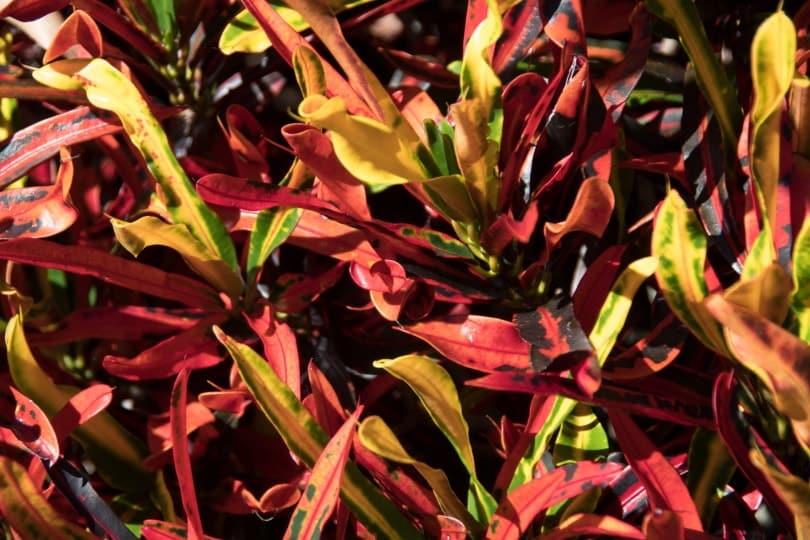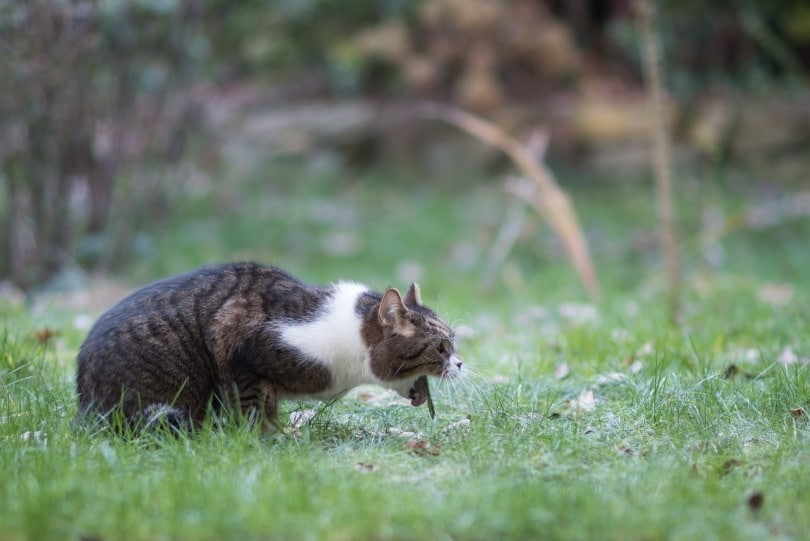The croton (Codiaeum variegatum) is a popular houseplant. This leafy, ornamental plant is native to tropical areas but adapts well indoors. But if you have a cat, this isn’t a plant you want in your home. All croton varieties—including evening embers, gold dust, and Zanzibar—are toxic to cats.
You can have pet-safe plants in your home if your cat eats a Croton plant. Find out what to do if your cat does this.
The croton is a beautiful houseplant known for its colorful, variegated leaves But is this popular plant toxic to cats? Unfortunately, the answer is yes – croton plants are poisonous to cats and dogs Here’s what you need to know about croton plant toxicity and what to do if your cat eats a croton leaf or stem.
Croton Toxicity in Cats
All parts of the croton plant (Codiaeum variegatum) contain toxins called diterpenoid phorbol esters. If ingested, these compounds can cause irritation to the mouth and digestive tract. The sap may also irritate the skin.
Common signs of croton poisoning in cats include
- Drooling
- Vomiting
- Diarrhea
- Loss of appetite
- Skin irritation if exposed to sap
Usually the irritation is minor, but cats have very sensitive digestive systems so croton plant toxins may hit them harder than other pets. Severe vomiting, diarrhea, lethargy or depression signals a more serious reaction requiring prompt veterinary care.
Kittens, smaller cats, and any cat with underlying health issues are most at risk for severe croton plant poisoning. Even small ingestions may cause concerning symptoms in delicate cats.
What to Do if Your Cat Eats a Croton Plant
If you catch your cat nibbling on or playing with a croton plant, take the following steps right away:
- Gently wipe out the mouth to remove any sap or plant material. Do not force the mouth open.
- Check for any evidence of skin irritation where sap may have gotten on your cat, and wash the area with soap and water.
- Identify what parts of the plant were chewed or ingested. Watch closely for any signs of drooling, vomiting, diarrhea or skin irritation over the next 6-12 hours.
- Contact your veterinarian or the ASPCA Poison Control Center for advice, especially if you don’t know what part of the plant was ingested. They can help assess risk and whether evaluation is needed based on your cat’s symptoms.
- If your cat seems ill or is vomiting/diarrheaing repeatedly, seek in-person vet assessment immediately. Croton poisoning can quickly lead to dehydration, especially in small cats.
- Bring a sample of the plant for identification and confirmation of exposure. The croton’s colorful variegated leaves are quite distinctive.
By quickly responding at the first sign your cat has tasted or chewed on any part of a croton plant, you can get ahead of more serious problems. Alert your vet to be safe. With prompt action, most cats recover fully.
How Much Croton is Toxic to Cats?
All parts of the croton plant are considered toxic to cats, including the stems, leaves, seeds and sap. Even small exposures should be taken seriously.
As little as a single croton leaf or bite of stem may cause drooling and oral irritation in some cats. Several leaves or multiple bites of stem often leads to vomiting/diarrhea. The more plant matter ingested, the greater the risk for gastrointestinal issues.
If the milky sap gets on a cat’s skin or in its mouth, it can cause significant localized irritation, drooling, and paw/face licking. Sap exposure may be more concerning than a minor nibble.
Since the toxicity depends on the individual cat and amount ingested, it’s impossible to give an “unsafe dose.” If your cat ate any part of a croton, assume it is potentially toxic and call your vet.
Are Croton Plants Deadly to Cats?
While croton plant poisoning can certainly make cats quite sick, it is not usually fatal with appropriate care.
Deaths from croton plant ingestion are very rare in cats. The primary danger is dehydration from profuse vomiting/diarrhea. With prompt veterinary treatment to control nausea, rehydrate, and support kidney function, most cats recover well.
Signs of a more severe reaction requiring emergency care include:
- Vomiting or diarrhea with blood
- Extreme lethargy, weakness or collapse
- Little to no urine production
- Ulceration of the mouth or tongue
- Respiratory distress
As long as you seek prompt vet care at the first sign of concerning symptoms, most cats survive croton poisoning without long-term effects. Still, it’s critical to keep this plant far out of paws’ reach!
Are Croton Plants Toxic to Other Pets?
Croton plants pose a risk not just to cats but also to dogs, rabbits, birds, reptiles, and other household pets if ingested. All parts of the plant contain irritating toxins.
Dogs tend to have less severe vomiting/diarrhea than cats when eating crotons. But the risks of dehydration and digestive irritation remain. Aggressive chewing of the woody stems could also pose a risk of oral damage or intestinal obstruction.
Small pets like rabbits, guinea pigs, birds and lizards are even more sensitive to toxins. Any ingestion of croton should be treated as an emergency for smaller exotic pets.
The bottom line – no pet should ever be given access to any part of a croton plant. It poses a needless poisoning risk.
Keeping Cats Safe from Croton Plants
To ensure your cat’s safety, follow these tips for cat-proofing croton houseplants:
- Keep crotons completely out of reach of cats at all times. Place on high shelves or in hanging baskets. Never keep crotons on floor levels or low tables.
- Monitor cats closely when first introducing a new croton plant. Some cats may be attracted to the unusual foliage.
- Keep crotons in rooms cats can’t access, such as a spare bedroom or closed office. Shut doors securely.
- Check new plants for bite marks or damage in case they were sampled when you weren’t looking.
- Opt for non-toxic cat safe houseplants like spider plants, ponytail palms and pothos.
- Use bitter tasting anti-chew sprays made for houseplants to deter nibbling.
- Wrap or sleeve the lower stems with decorative covers to prevent chewing.
Remember, it only takes one bite for a toxic reaction. Total prevention is key to avoid catastrophe with poisonous houseplants like croton.
Can Cats Recover from Croton Poisoning?
With prompt veterinary treatment, most cats make a full recovery after eating part of a poisonous croton plant.
Treatment focuses on:
- Controlling nausea and vomiting with medications like Cerenia.
- Managing diarrhea with drugs like metronidazole.
- Rehydrating with intravenous or subcutaneous fluids.
- Monitoring kidney function.
- Pain control if severe mouth/tongue irritation or ulcers are present.
Usually within 24-48 hours of supportive care, cats are back to normal with no lasting effects. The prognosis is good if addressed quickly before dehydration sets in.
However, any mouth or tongue ulcers may take 1-2 weeks to fully heal. Cats may resist eating or seem painful when swallowing during recovery. Soft foods, syringe feeding, and pain medication help during this healing phase.
With vigilant monitoring and care, most cats are back to their old selves quickly after croton plant poisoning. But prevention is definitely better than treatment!
Key Takeaways on Croton Toxicity in Cats
To summarize key points on croton plant risks for cats:
-
All parts of croton plants, including leaves, stems, and sap, contain irritating toxins harmful to cats if ingested or contacted.
-
Vomiting, diarrhea, drooling, loss of appetite and lethargy are common signs of poisoning.
-
Immediately contact your vet if your cat eats any part of a croton plant. Prompt treatment is key.
-
While serious, croton poisoning is rarely fatal in cats with appropriate supportive veterinary care and decontamination.
-
Thoroughly cat-proof your home to keep croton plants completely out of paws’ reach. Prevention is critical.
While beautiful, croton houseplants pose a severe poison risk for curious cats. Always place them well out of reach and supervise any initial introductions. With prevention and preparedness, you can help keep your cat safe while still enjoying these gorgeous plants!
Frequently Asked Questions about Croton Plants and Cats
Here are answers to some common questions about croton plant toxicity and cats:
How long do croton poisoning symptoms last in cats?
With treatment, symptoms usually resolve within 24-48 hours. Vomiting and diarrhea typically stop within the first 12-24 hours. Oral ulceration may persist slightly longer as the damaged tissue heals.
What part of the croton plant is most toxic?
All parts are toxic, including leaves, stems, sap and seeds. The highest concentration of toxins is typically in the sap, seeds and younger leaves. But even mature leaves and woody stems can absolutely cause a reaction if ingested.
Is it OK for cats to eat croton leaves?
No, cats should never purposefully be allowed to eat or chew any part of a croton plant. Even a small amount can cause mouth irritation, vomiting or diarrhea. Assume all parts are toxic.
Can cats die from eating croton plants?
It is very rare for cat croton poisoning to be fatal with prompt vet care. However, untreated severe vomiting or diarrhea can lead to dangerous dehydration, especially in very small or frail cats. So immediate treatment is critical.
How much croton leaf is toxic to cats?
There is no “safe” amount of croton plant cats can ingest. Even a small bite of a leaf or leaf tip may irritate the mouth. A couple leaves could cause gastrointestinal signs. Immediately contact your vet after any exposure.
Will a cat be OK if it eats a croton plant?
With rapid veterinary care, most cats recover fully after eating part of a croton plant. But it’s still extremely dangerous and should be avoided. Prompt decontamination and treatment are essential for the best outcome. Never purposefully let cats access crotons.
How long after eating a croton will a cat get sick?
Cats often start drooling and lip licking immediately after munching croton leaves or sap. Vomiting and diarrhea typically start within 4-12 hours of exposure. If no symptoms appear within 24 hours, toxicity is unlikely but still contact your vet.
What if my cat licks croton sap off its fur?
Immediately use a pet safe wipe or washcloth with warm soapy water to remove any sap residue from fur. Then rinse thoroughly. Watch closely for signs of mouth or skin irritation which may develop over the next day. Contact your vet with any concerns.
How do I make my cat vomit after eating croton?
Never induce vomiting at home unless specifically instructed by poison control or your veterinarian. They may advise waiting and monitoring rather than inducing vomiting, depending on the circumstances. Let the experts guide you.
Are Croton Leaves Poisonous to Cats?
You should assume that all parts of a Croton plant are toxic to cats, as they contain phorbol esters and stimulate protein kinase C. But it may be helpful to your veterinarian if you can tell them whether your cat ate a leaf, root, or another part of the plant. If your cat consumes any part of a Croton plant, follow the steps below.

How Do I Know if My Cat Ate a Poisonous Plant?
Cats that get into poisonous plants may display these signs:
- Diarrhea
- Vomiting
- Drooling
- Skin irritation
- Lethargy
- Change in heart rate or breathing
You should bring a picture or a piece of the plant with you to the vet if you don’t know what it is called.

Plants That Are Toxic to Cats!!
- The Ultimate Guide to Growing Strawberries in Raised Beds - August 8, 2025
- No-Dig Garden Beds: The Easiest Way to Grow a Beautiful Garden - August 6, 2025
- How to Protect and Preserve Wood for Raised Garden Beds - August 6, 2025

